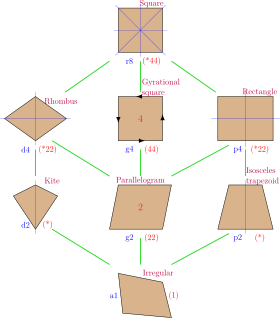
Back معين (هندسة رياضية) Arabic ৰম্বাছ Assamese Rombu AST Romb Azerbaijani Ромб Bashkir Rombus BCL Ромб Byelorussian Ромб BE-X-OLD Ромб Bulgarian রম্বস Bengali/Bangla
| Rhombus | |
|---|---|
 A rhombus in two different orientations | |
| Type | quadrilateral, trapezoid, parallelogram, kite |
| Edges and vertices | 4 |
| Schläfli symbol | { } + { } {2α} |
| Coxeter–Dynkin diagrams | |
| Symmetry group | Dihedral (D2), [2], (*22), order 4 |
| Area | (half the product of the diagonals) |
| Properties | convex, isotoxal |
| Dual polygon | rectangle |

In plane Euclidean geometry, a rhombus (pl.: rhombi or rhombuses) is a quadrilateral whose four sides all have the same length. Another name is equilateral quadrilateral, since equilateral means that all of its sides are equal in length. The rhombus is often called a "diamond", after the diamonds suit in playing cards which resembles the projection of an octahedral diamond, or a lozenge, though the former sometimes refers specifically to a rhombus with a 60° angle (which some authors call a calisson after the French sweet[1]—also see Polyiamond), and the latter sometimes refers specifically to a rhombus with a 45° angle.
Every rhombus is simple (non-self-intersecting), and is a special case of a parallelogram and a kite. A rhombus with right angles is a square.[2]
- ^ Alsina, Claudi; Nelsen, Roger B. (31 December 2015). A Mathematical Space Odyssey: Solid Geometry in the 21st Century. American Mathematical Soc. ISBN 9781614442165.
- ^ Note: Euclid's original definition and some English dictionaries' definition of rhombus excludes squares, but modern mathematicians prefer the inclusive definition. See, e.g., De Villiers, Michael (February 1994). "The role and function of a hierarchical classification of quadrilaterals". For the Learning of Mathematics. 14 (1): 11–18. JSTOR 40248098.
© MMXXIII Rich X Search. We shall prevail. All rights reserved. Rich X Search
